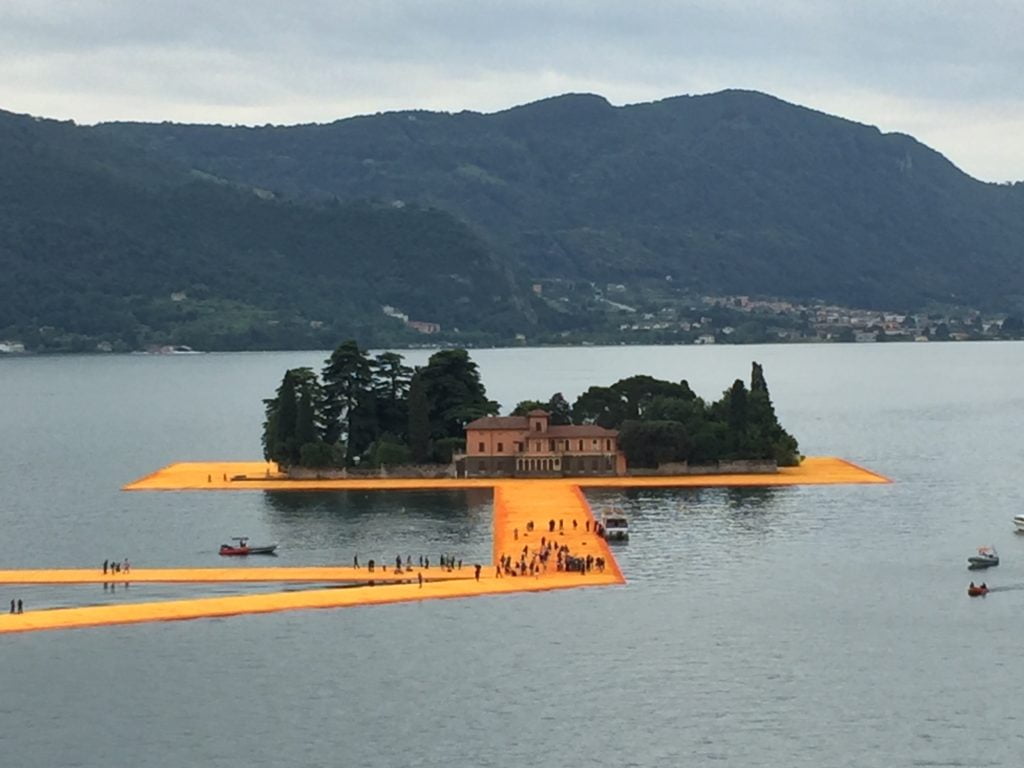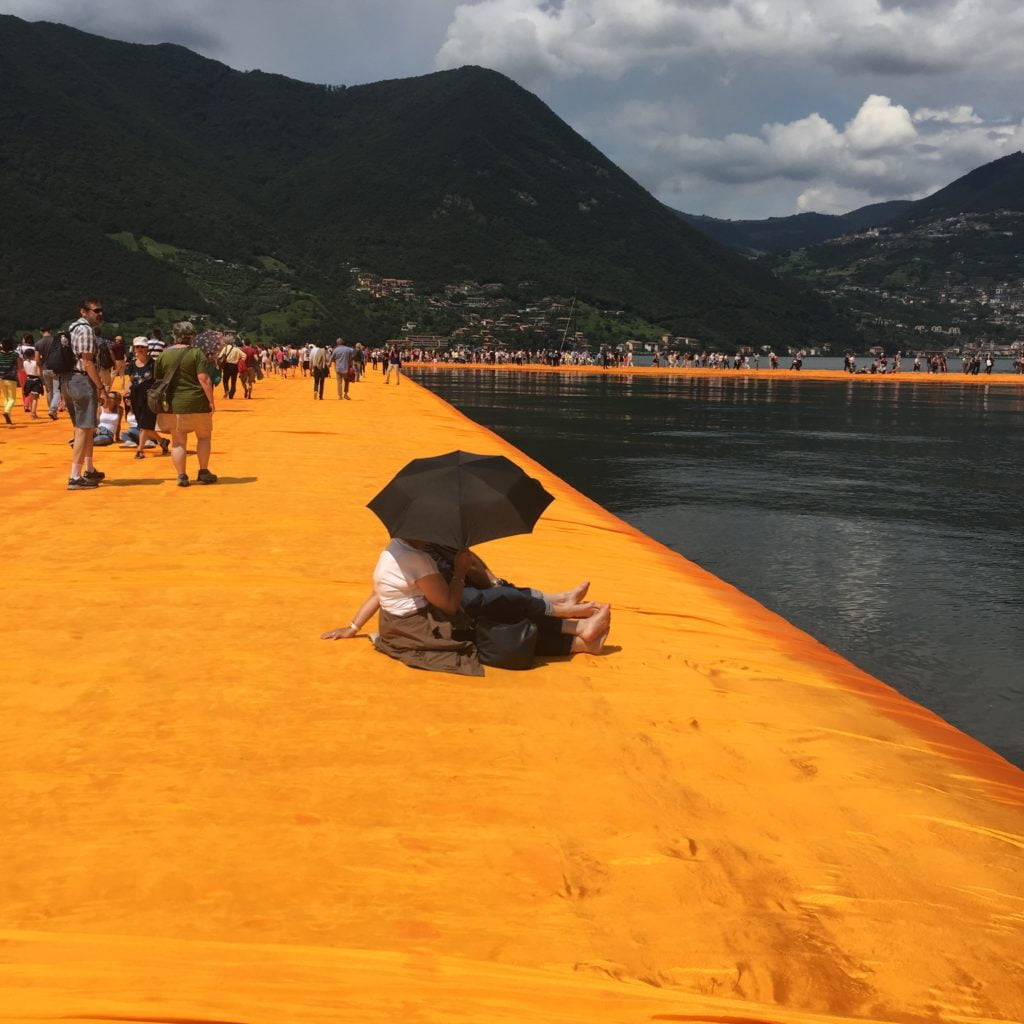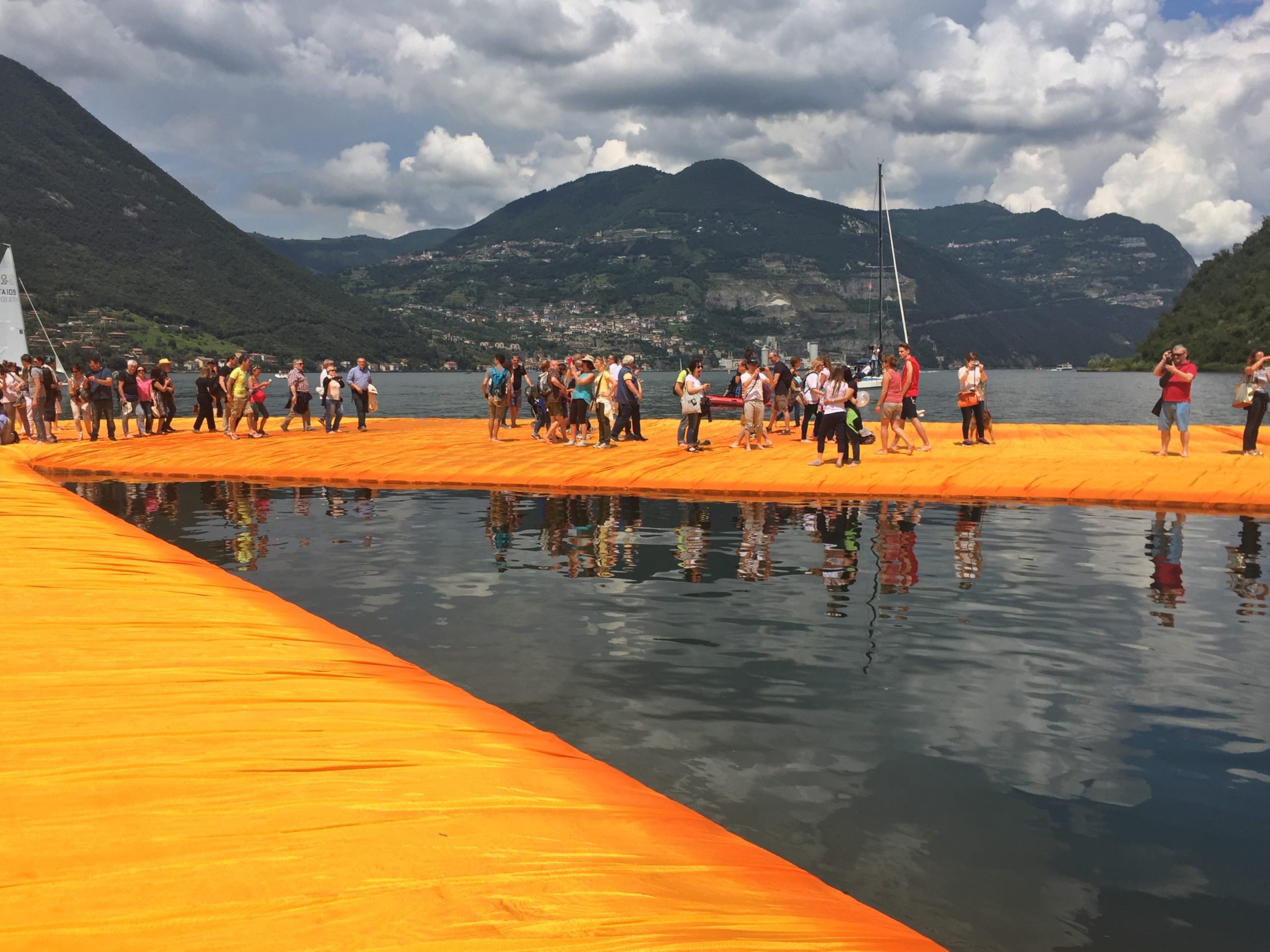Yes, I was there. I too, walked on Christo’s Floating piers. It’s such a rare pleasure to be at the right place at the right time in our perpetual state of missing out, so typical of an existence overloaded with events and stimuli. Maybe that's what motivated 1.2 million visitors to visit Lago D'Iseo in north Italy during 16 days in June. Maybe that's the reason Tom Cruz sent agents to scout for accommodation on the lake – money no object.
From the moment I read about Christo’s project last October, I knew I wouldn’t miss it. His Gates in New York’s Central Park in 2005 brought tears of joy to my eyes. It was one of those rare events that make you forget your troubles and the world beyond, focusing on the harmony of all elements around you – Happiness.
He has been branded as the artist who wraps things. This habit began in the 1950’s, with small mundane objects, wrapped in a way that gave them a sculptural quality. By the end of the 60’s he had wrapped a bay in Australia that became the largest art project of its time. In the summer of 1985 Christo wrapped the Pont Neuf bridge in Paris, in 1995 the Reichstag building in Berlin and in 1998 he wrapped 178 trees in Basel. Other famous works include surrounding 11 islands in Miami bay with pink fabric, 5,000 bright orange Gates in New York City and now he has completed the Floating piers, a project conceived in 1970 together with his life and business partner Jean-Claude. It was originally proposed for Delta della Plata in Argentina but after waiting eight years for a permit, they gave up. The second suggested location was Tokyo bay but that also fell through. In 2009 sadly Jeanne-Claude passed away and in 2014 Christo chose Lago D’Iseo, although the fourth largest lake in Italy, still relatively off the tourist map. Sitting in the middle of the lake is Monte Isola, a large mountain island.




There are also a few tiny private islands, like San Paolo, belonging to the Baretta family, yes as in the pistols.
The Floating piers connected Monte Isola to the mainland and also to San Paolo, private property, surrounded by a wall which could only be walked around. Thus, for the first time in history, the residents of Monte Isola could walk to Sulzano in the mainland and visa versa, but only for 16 days.
200,000 cubical floats were connected to create the piers, 3 km long and 16 meters wide. Another 2.5 km of the project were on land in the small towns of Sulzano and Peschiera Maraglio. These were covered in 70,000 square meters of white felt and topped with 100,000 square meters of saffron colored nylon fabric, weaved especially for the project. The cost, 18 million dollars, was secured, as with all Christo’s projects, by the artist himself, from the sale of sketches and paintings of the project.
Self funding is only one of Christo’s principles. He could easily fund his projects with a fashionable kickstart campaign but the freedom he achieves by self funding is basic in his creation, as is also free entry to his projects. He wants everybody to enjoy his art. Another amazing fact about Christo: he doesn’t commercialize. There is no merchandise, no souvenir stands, only small pieces of the golden fabric that were distributed by the project team to everyone who walked down onto the piers (some have already been put up for sale on ebay).
1,000 workers (all paid) installed the project, all wearing black logo uniforms and equipped with brand new tool bags. 30 new rubber boats transported materials on site. The floating piers supplied work to many factories in Italy, also manufacturing 37,000 meters of rope that were tied to 200 anchors at the bottom of the lake.
Personally, the best part of the experience was being on site for three days before the project actually opened to the public. In those quiet days we felt privileged to witness the meticulous production, the attention to detail and the planning that had gone into this huge project.
My first glimpse of it was from 30,000 feet, as we flew over lake Iseo towards landing in Milan and I happened to look out the window.
They had not yet started to put down the saffron fabric, in fact they seemed to be waiting just for us as the first section in the small town was being covered just as we entered Sulzano.
Each section of the land walkway had been mapped and the felt and fabric cut to size in advance, taking into consideration every bench, tree, bush and lamppost. The fabric was distributed in sacks according to its location. Nothing was cut on site.





There were the tackers, tacking the ends, there were the sewers, on their knees with needle and thread – the same thread from which the fabric was weaved and there was someone threading the needles for them. The atmosphere was electrified with excitement, everybody knowing they were a part of a historical project and the acknowledgement of its short life span did not deter their enthusiasm, on the contrary – it augmented it.
I was asked why he did it. Why invest so much for such a short project? This is a utilitarian question asked by rational people living in a practical world. We are lucky to have visionaries among us that pragmatism doesn’t concern them as they plan irrational, illogic and non-economical enterprises.
Christo is concerned with passion, not needs. To our delight, he can afford to realize his dreams and share them with the world. The Floating Piers was the first of Christo’s project that demanded active participation, unlike others that were merely viewed. The physical experience of walking on the floats was multi-sensory: the rocking caused by the movement of the water, the amazing colors of saffron, blue and green, feeling the wind, the sun or rain, the texture of the fabric under your feet.
So what actually was the Floating piers? It was an artistic event, a cultural experience and mostly a demonstration of freedom. From the moment Christo’s project materialized, he let it go and gave it to the world. His projects belong to no-one and everyone. Nobody can buy them or claim ownership. This freedom requires temporality, a concept that is alien to models of collecting and preserving art for eternity. The only “pieces of Christo” available to collectors are the preliminary works sold to fund his projects, and they do in fact sell for very high prices. It’s interesting to know that once realized, no more sketches will be made. Christo is already busy with his next project.
There are two projects on hand: On the river in Colorado and the Mastaba, a 150 meter high pyramid made of oil barrels in Abu Dhabi that will be the highest statue in the world and Christo’s first permanent work.



Not all sparkled on the floating Piers. The number of visitors was much higher than anticipated. The expansive transportation manual was prepared for a half a million, not 1.2 million visitors. The trains and shuttles were not prepared for such a mass and the crowds caused congestions in train stations and hours of waiting for the shuttle buses. The crowds on the piers caused unexpected wear and tear so after a few days the project managers decided to close the piers between midnight and 6am for repairs and also to reduce the pressure and noise, offering relief for the tired locals. This area is usually very peaceful and with all the enthusiasm and business opportunities, the few local restaurants continued to close for siesta as usual. No art project or hungry crowds will stop an Italian from having his siesta!
At midnight between the 2nd and 3rd of July the piers were disconnected from the mainland. The residents of Monte Isola went back to using the ferry. All the dismantled materials will be recycled and although no physical materials remain, the Floating Piers will live on forever online, in tens of thousands photographs and videos and mainly, they will remain eternally in the memories and hearts of all who experienced them.

Photograpy © Debby Luzia

Thank you very much for your wonderful article, Debby. Regretfully I was unable to visit the floating piers. I met Christo a few years ago when he was already planning his work with the oil barrels in the Abu Dhabi desert. He is an artist I much admire for the reason you stated. More than ever we need artists like him, regardless of their discipline, offering imagination, beauty and hope in this precarious time.
Hi Renee, so glad you enjoyed my article. I’d love to hear more about your meeting with Christo. What were the circumstances?
I saw him on the day before the opening, as he was testing the piers. There were a few more people standing next to us and we applauded and cheered. He looked quite embarrassed, even shy, actually.
I completely agree that the world needs more artists like him but I’m sure other artists contribute to society on smaller scales. It’s the scope of his work which is so amazing.
Thank you for the explanation and the insight into Christo’s process. Angry people attack him for the inconveniences caused to their lives eith directly or vicariously. It seems interesting (from the luxury of my non-participation) that there should be such vehemence over someone who presented a gift that cannot be purchased to the world. And the dry goes up yet a again, on the waste of money when he could feed the poor.
But he did. We are impoverished in precisely those things that he built into this and his other projects.
I experienced the “Gates” ever so briefly, but the experience is indelibly imprinted. Christo seems to insist that we commune with each other on the levels and measurements that really matter, and for that, we should thank him. And if, as a result of the experience, one should have a compassion for the impoverished, it is for them to on their compassion in their chosen way.
Hello Stephen and thanks you for your great comment. I know exactly what you mean as I myself heard a woman in Central Park during the Gates, complaining to one of the attendants that she “wants her park back”…
Art doesn’t have the same meaning to all but you would think that today, more than ever, as contemporary art has become inaccessible to the majority, projects like these that celebrate beauty, that are free and don’t burden the tax payers, would enjoy wall to wall appreciation.
Unfortunately for them, there are people who choose a negative approach to their surroundings. their loss…
Cheers!